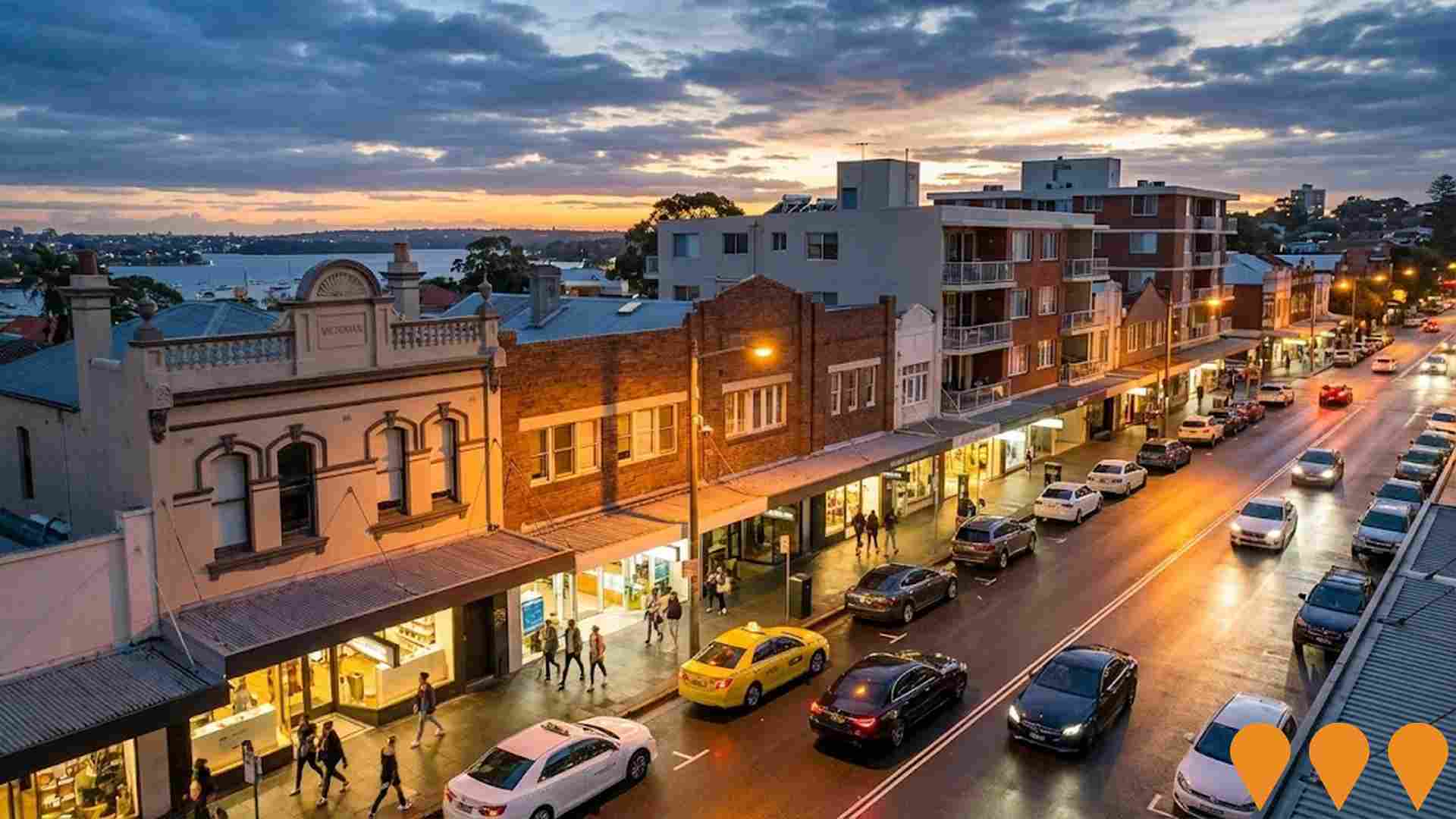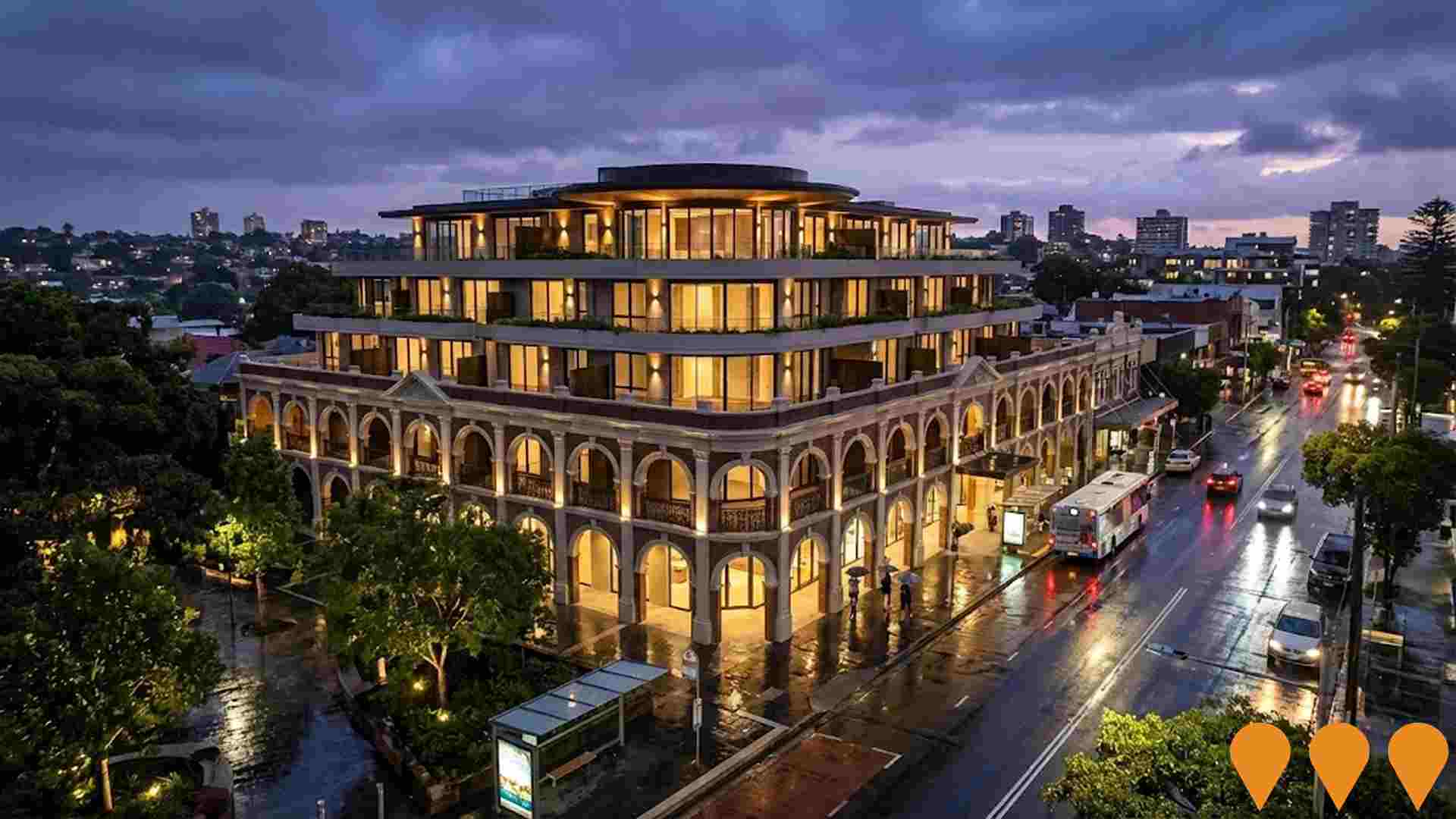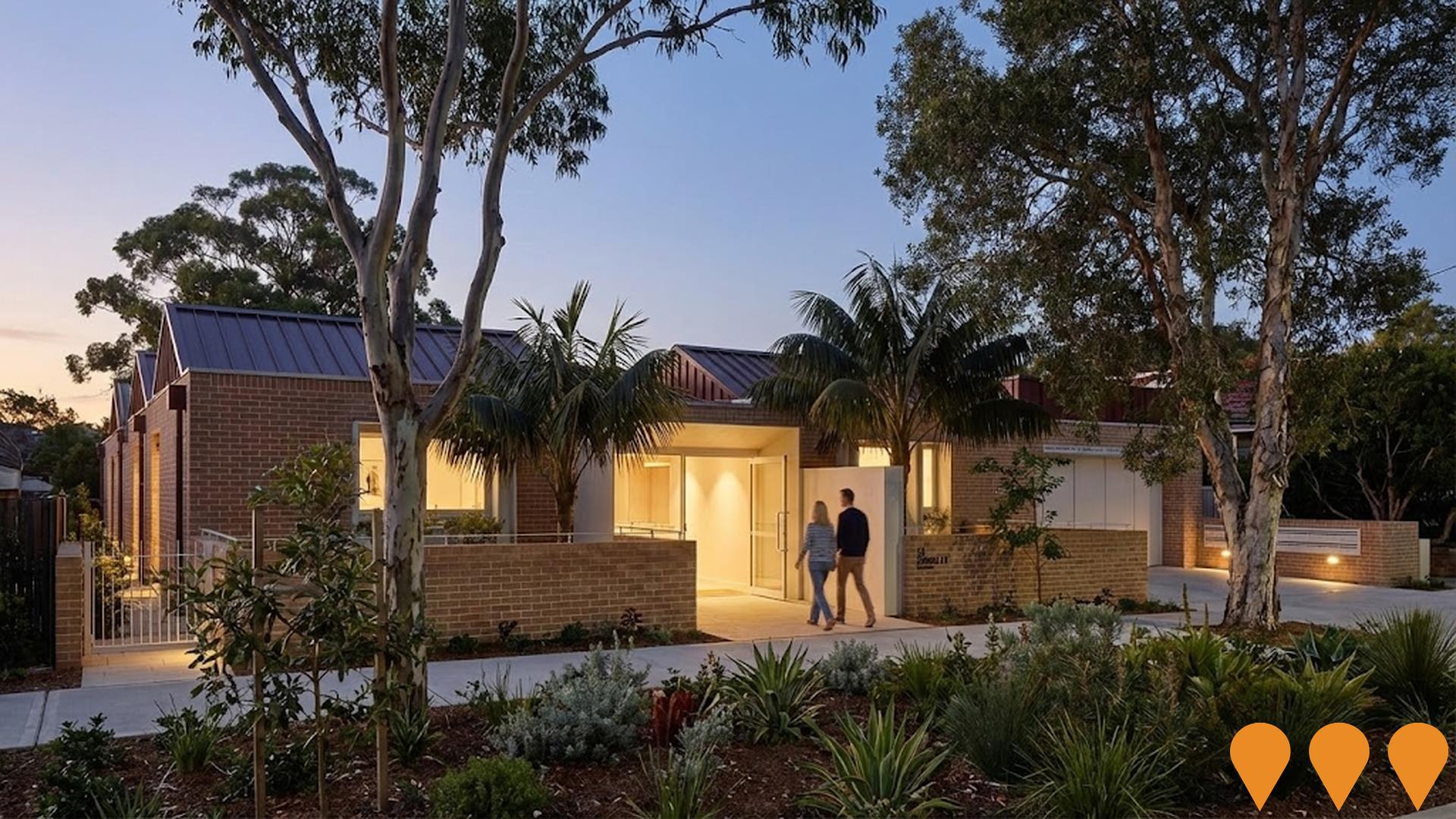Chart Color Schemes
est. as @ -- *
ABS ERP | -- people | --
2021 Census | -- people
Sales Activity
Curious about local property values? Filter the chart to assess the volume and appreciation (including resales) trends and regional comparisons, or scroll to the map below view this information at an individual property level.
Find a Recent Sale
Sales Detail
Population
Mosman - South has shown very soft population growth performance across periods assessed by AreaSearch
Mosman - South's population was around 14,877 as of August 2025. This showed an increase of 312 people from the 2021 Census figure of 14,565, reflecting a 2.1% rise since then. The change is inferred from ABS's estimated resident population of 14,900 in June 2024 and address validation since the Census date. This results in a population density ratio of 2,770 persons per square kilometer, placing Mosman - South in the upper quartile nationally according to AreaSearch's assessments. Overseas migration contributed approximately 87.8% of total population gains recently.
AreaSearch uses ABS/Geoscience Australia projections for each SA2 area, released in 2024 with a base year of 2022. For areas not covered by this data, AreaSearch utilises NSW State Government's SA2 level projections from 2022 using a 2021 base year. Growth rates by age group are applied to all areas for the years 2032 to 2041. By 2041, Mosman - South's population is projected to decrease by 458 persons overall, but specific age cohorts like those aged 85 and over are expected to grow, with a projected increase of 636 people in that group.
Frequently Asked Questions - Population
Development
AreaSearch assessment of residential development drivers sees a low level of activity in Mosman - South, placing the area among the bottom 25% of areas assessed nationally
Mosman - South has seen approximately 23 new homes approved annually over the past five financial years from FY18 to FY22, totalling 118 homes. As of FY26, four approvals have been recorded so far. Despite population decline during this period, development activity has been adequate relative to population changes. The average expected construction cost value for new homes is $1,843,000, indicating a focus on the premium market with high-end developments.
In terms of commercial development, $13.5 million in approvals have been registered in FY26. Compared to Greater Sydney, Mosman - South shows around 75% of construction activity per person and ranks among the 30th percentile nationally for areas assessed, suggesting limited choices for buyers but supporting demand for existing dwellings. Recent construction comprises 41.0% standalone homes and 59.0% attached dwellings, favouring compact living which attracts downsizers, investors, and first-time purchasers. The area has approximately 593 people per dwelling approval, indicating an established market with stable or declining population projections, reducing housing demand pressures and benefiting potential buyers.
With population projections showing stability or decline, Mosman - South should see reduced housing demand pressures, benefiting potential buyers.
Frequently Asked Questions - Development
Infrastructure
Mosman - South has very high levels of nearby infrastructure activity, ranking in the top 20% nationally
Changes in local infrastructure significantly affect an area's performance. AreaSearch has identified 38 projects likely to impact the area. Notable projects include Eleve Cremorne, Park Residences Cremorne, Mosman Residences, and Huntington Residences Cremorne. The following list details those most relevant.
Professional plan users can use the search below to filter and access additional projects.
INFRASTRUCTURE SEARCH
 Denotes AI-based impression for illustrative purposes only, not to be taken as definitive under any circumstances. Please follow links and conduct other investigations from the project's source for actual imagery. Developers and project owners wishing us to use original imagery please Contact Us and we will do so.
Denotes AI-based impression for illustrative purposes only, not to be taken as definitive under any circumstances. Please follow links and conduct other investigations from the project's source for actual imagery. Developers and project owners wishing us to use original imagery please Contact Us and we will do so.
Frequently Asked Questions - Infrastructure
Taronga Zoo Sky Safari Upgrade
Upgrade of the Sky Safari cable car at Taronga Zoo Sydney to include larger, more accessible gondolas, new loading and unloading stations, and enhanced visitor experience. The project aims to improve accessibility, replace the retired system, and provide panoramic views over the zoo and Sydney Harbour.

Military Road Mega Lot Apartment Development
State Significant Development comprising amalgamation of Honeysuckle Garden nursery and Midas Tyre Auto Service sites into a 3,207sqm mega lot for 107 new apartments up to eight storeys with 3% affordable housing. Declared SSD by NSW Planning Minister on June 12, 2025, bypassing local council approval and being fast-tracked through Housing Delivery Authority assessment within 275 days.

Huntington Residences Cremorne
A luxury $42 million apartment development by WINIM featuring 13 one, two and three-bedroom apartments. The development combines restoration of the 1937 Clifford Finch building with contemporary architecture, inspired by Cremorne's natural beauty and Robertsons Point Lighthouse.

Park Residences Cremorne
A boutique development by Abadeen featuring 2 and 3 bedroom apartments with panoramic Middle Harbour views. Designed by MHNDU Architects with premium finishes including V-Zug appliances, natural stone benchtops, and communal wine cellar.
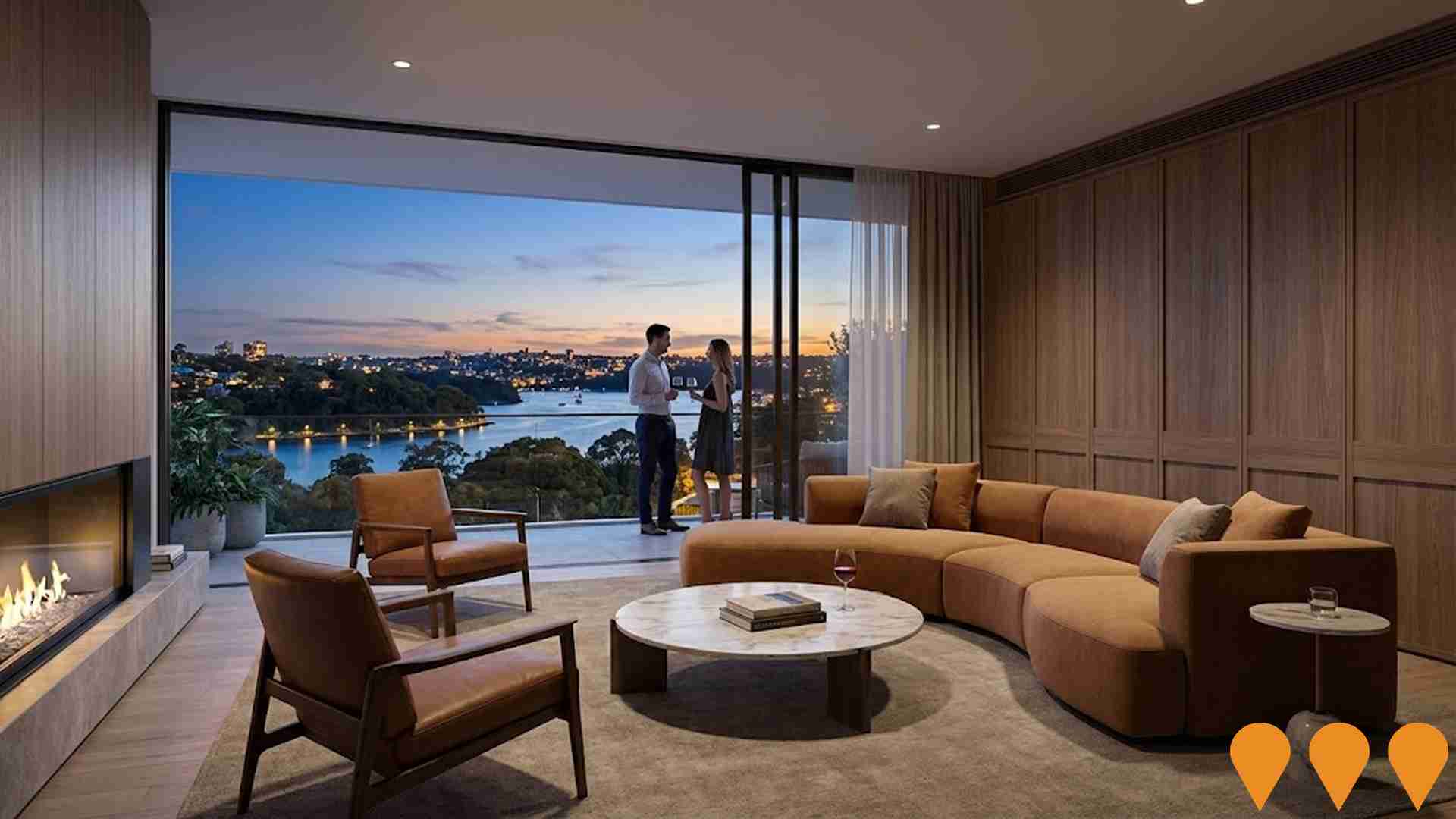
The Alexander Luxury Living
$30 million luxury seniors housing development on the historic Ellamatta mansion site in Mosman, featuring refurbishment of the existing mansion for common areas and seniors living spaces, along with 23 independent living units on a 7648 sqm site adjacent to the existing Glengarry aged care facility.
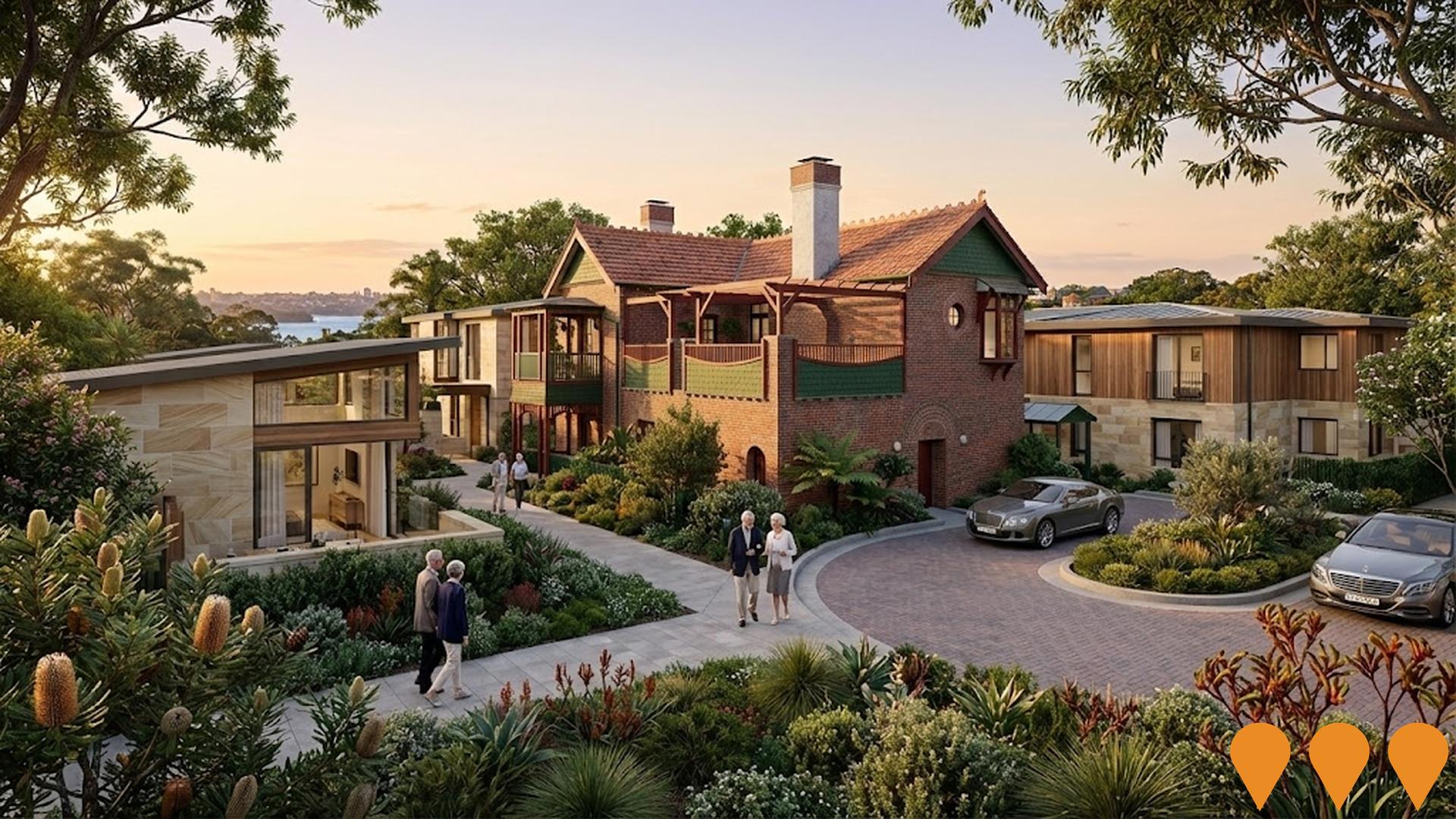
South Mosman Wharf Upgrade
Completed upgrade of South Mosman Wharf as part of the Safe Accessible Transport program, featuring a new floating pontoon with covered waiting area, passenger seating, glass weather screens, information boards, new lift providing access for all passengers, covered stairs and gangway, enhanced safety features including CCTV cameras, lighting, and tactile ground surface indicators, plus three new bicycle parking hoops at street level. The upgrade ensures compliance with Disability Discrimination Act 1992 and Disability Standards for Accessible Public Transport 2002.

Eleve Cremorne
A boutique development of 22 oversized apartments by HELM featuring 1, 2 and 3 bedroom units. Designed with marble finishes, Miele appliances, European oak timber flooring, and Cavalier Bremworth wool carpet, within walking distance of Cremorne Village.
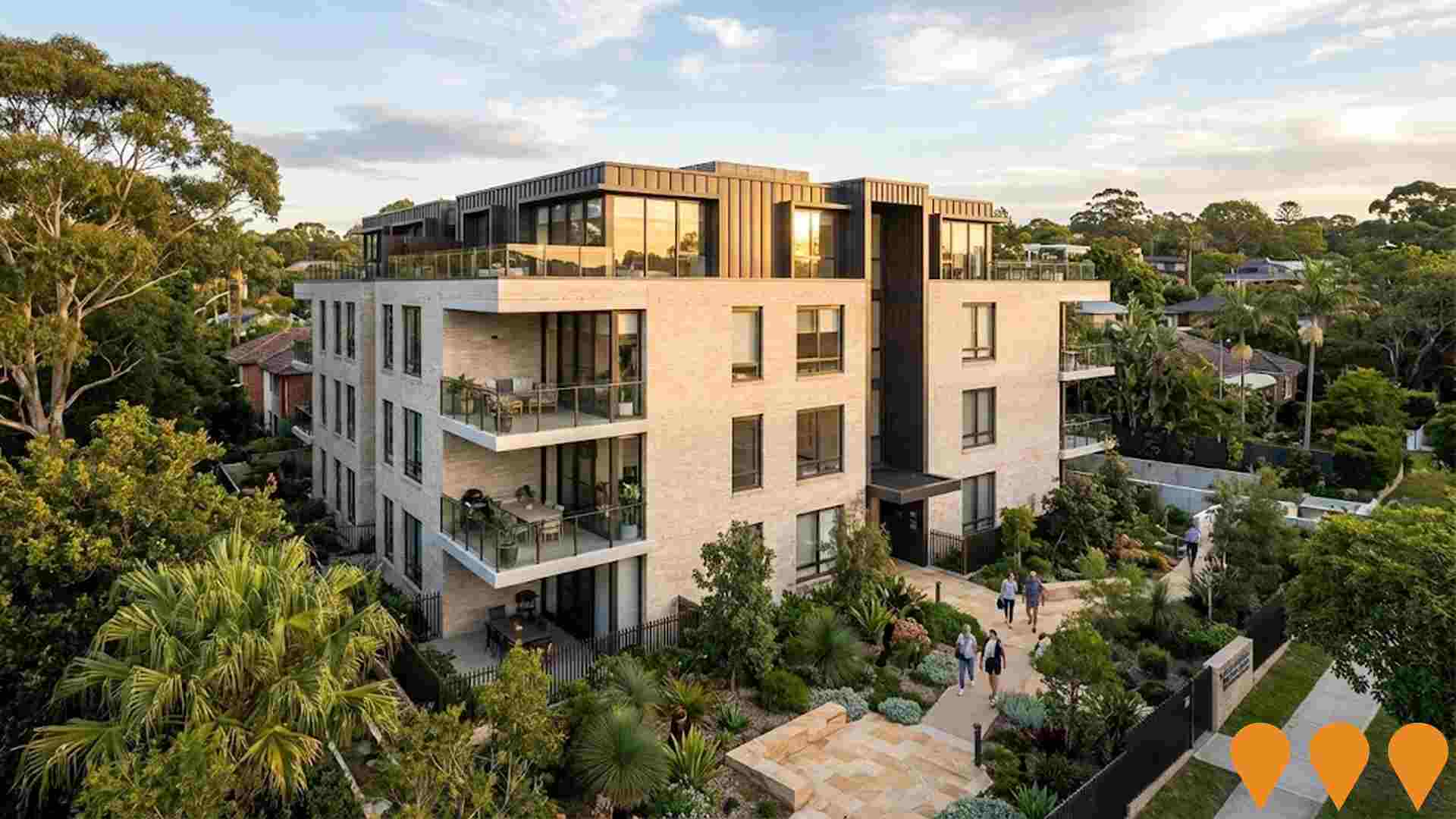
284B Military Road Mixed Use Development
Mixed-use residential and commercial development along the Military Road corridor, contributing to urban renewal and increased housing diversity in the Cremorne precinct.
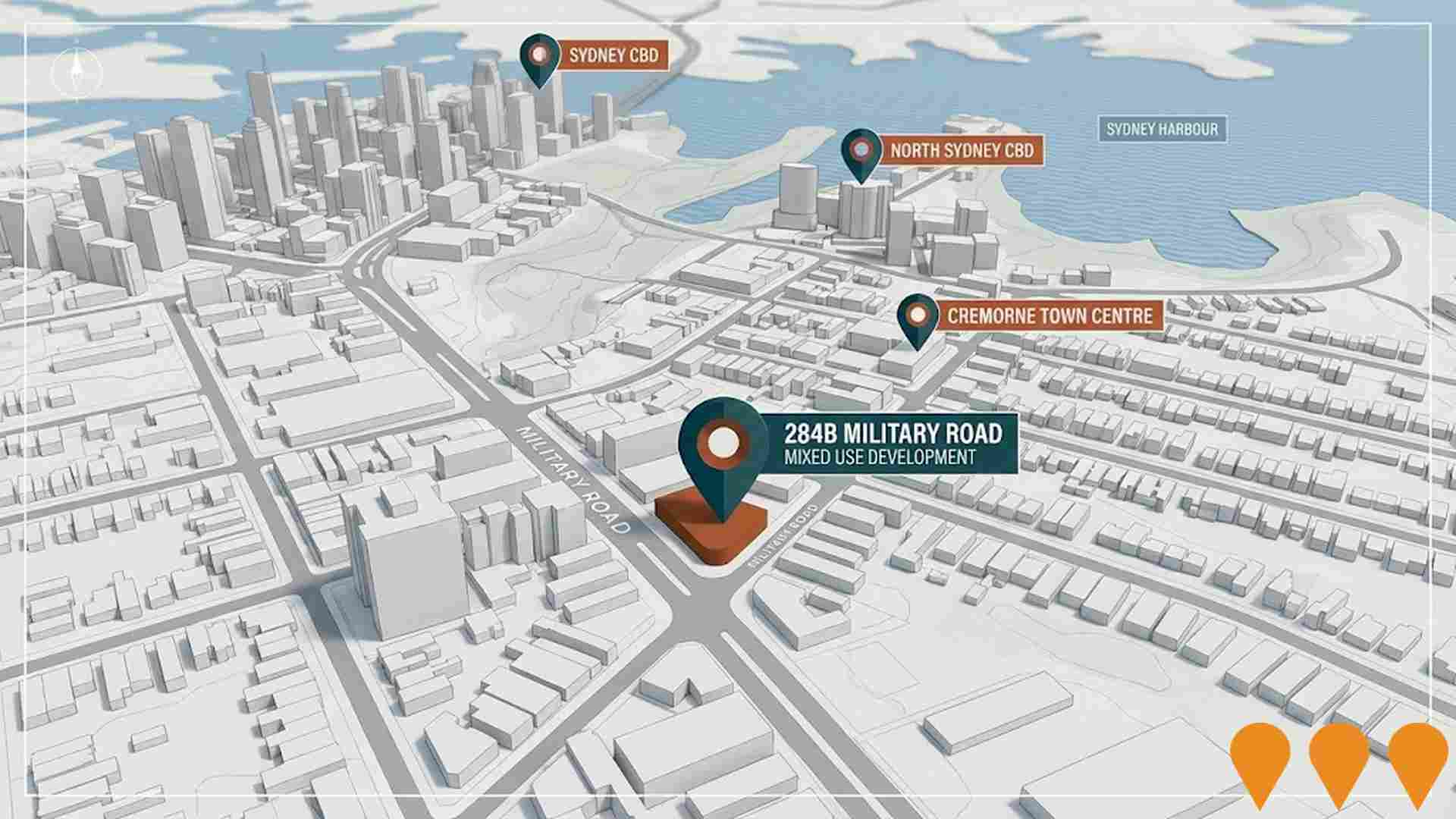
Employment
While Mosman - South retains a healthy unemployment rate of 3.9%, recent employment declines have impacted its national performance ranking
Mosman - South has an educated workforce with a notable technology sector presence and an unemployment rate of 3.9% as of June 2025. There are 8,202 residents employed, with an unemployment rate of 0.3% lower than Greater Sydney's 4.2%.
Workforce participation is 63.5%, similar to Greater Sydney's 60.0%. Key industries include professional & technical, finance & insurance, and health care & social assistance. The area specializes in professional & technical jobs, with an employment share of 1.8 times the regional level. Construction is under-represented at 4.0%, compared to Greater Sydney's 8.6%.
Between June 2024 and June 2025, Mosman - South's labour force decreased by 0.2% and employment declined by 1.7%, increasing unemployment by 1.4 percentage points. In contrast, Greater Sydney saw employment rise by 2.6% and the labour force grow by 2.9%. National employment forecasts from Jobs and Skills Australia (May 2025) project a 6.6% growth over five years and 13.7% over ten years. Applying these projections to Mosman - South's industry mix suggests local growth of approximately 7.7% over five years and 15.1% over ten years, though this is a simplified extrapolation for illustrative purposes only.
Frequently Asked Questions - Employment
Income
The economic profile demonstrates exceptional strength, placing the area among the top 10% nationally based on comprehensive AreaSearch income analysis
Mosman - South had a median taxpayer income of $81,647 and an average of $215,223 in the financial year 2022, according to postcode level ATO data aggregated by AreaSearch. This is notably high compared to Greater Sydney's median income of $56,994 and average income of $80,856. By September 2025, estimated incomes would be approximately $91,943 (median) and $242,363 (average), based on Wage Price Index growth of 12.61% since the financial year 2022. The 2021 Census data shows that household, family, and personal incomes in Mosman - South rank highly nationally, between the 97th and 98th percentiles. Income distribution reveals that 40.7% of locals (6,054 people) fall into the $4,000+ category, differing from the regional norm where the $1,500 - $2,999 category is predominant at 30.9%. A significant 49.8% earn above $3,000 weekly. High housing costs consume 15.5% of income, but strong earnings place disposable income at the 96th percentile. The area's SEIFA income ranking places it in the 10th decile.
Frequently Asked Questions - Income
Housing
Mosman - South features a more urban dwelling mix with significant apartment living, with above-average rates of outright home ownership
Dwelling structure in Mosman - South, as per the latest Census, consisted of 37.3% houses and 62.8% other dwellings (semi-detached, apartments, 'other' dwellings). In comparison, Sydney metro had 17.9% houses and 82.1% other dwellings. Home ownership in Mosman - South was 36.9%, with the remainder being mortgaged (27.3%) or rented (35.8%). The median monthly mortgage repayment was $4,000, higher than Sydney metro's $3,085 and significantly above the national average of $1,863. The median weekly rent in Mosman - South was $580, compared to Sydney metro's $582 and substantially above the national figure of $375.
Frequently Asked Questions - Housing
Household Composition
Mosman - South features high concentrations of lone person households, with a higher-than-average median household size
Family households constitute 66.6% of all households, including 30.7% couples with children, 27.4% couples without children, and 7.7% single parent families. Non-family households account for the remaining 33.4%, with lone person households at 31.2% and group households comprising 2.3% of the total. The median household size is 2.3 people, which is larger than the Greater Sydney average of 2.1.
Frequently Asked Questions - Households
Local Schools & Education
Educational achievement in Mosman - South places it within the top 10% nationally, reflecting strong academic performance and high qualification levels across the community
Educational attainment in Mosman - South is notably high with 60.6% of residents aged 15+ holding university qualifications, exceeding the Australian average of 30.4% and the NSW average of 32.2%. Bachelor degrees are the most common at 38.5%, followed by postgraduate qualifications (18.3%) and graduate diplomas (3.8%). Vocational pathways account for 17.2% of qualifications among those aged 15+, with advanced diplomas making up 10.0% and certificates 7.2%. Educational participation is high, with 29.1% of residents currently enrolled in formal education.
This includes 9.1% in primary, 8.7% in secondary, and 6.8% pursuing tertiary education. Mosman - South has a robust network of 6 schools educating approximately 2,223 students. The area demonstrates exceptional educational performance with an ICSEA score of 1169, placing local schools among the most advantaged nationally. Education provision is balanced with 5 primary and 1 secondary school serving distinct age groups. School places per 100 residents (14.9) fall below the regional average (19.2), indicating some students may attend schools in adjacent areas. Note: where schools show 'n/a' for enrolments, please refer to the parent campus.
Frequently Asked Questions - Education
Schools Detail
Nearby Services & Amenities
Transport
Transport servicing is high compared to other areas nationally based on assessment of service frequency, route connectivity and accessibility
Mosman - South has 111 active public transport stops. These are a mix of ferry and bus services. There are 47 individual routes operating in total.
Each week, these routes provide 10,709 passenger trips collectively. Residents enjoy excellent transport accessibility, with an average distance of 111 meters to the nearest stop. Daily service frequency averages 1,529 trips across all routes, equating to approximately 96 weekly trips per individual stop.
Frequently Asked Questions - Transport
Transport Stops Detail
Health
Mosman - South's residents boast exceedingly positive health performance metrics with very low prevalence of common health conditions across all age groups
Mosman - South's health outcomes show excellent results with low prevalence of common conditions across all ages. Private health cover stands at approximately 94%, compared to Greater Sydney's 86.4% and the national average of 55.3%. Asthma and arthritis are the most prevalent conditions, affecting 6.5% and 5.8% respectively.
75.6% report no medical ailments, similar to Greater Sydney's 75.2%. The area has a higher proportion of seniors aged 65+, at 21.9%, compared to Greater Sydney's 20.1%. Senior health outcomes are notably strong, outperforming the general population in health metrics.
Frequently Asked Questions - Health
Cultural Diversity
Mosman - South was found to be more culturally diverse than the vast majority of local markets in Australia, upon assessment of a range of language and cultural background related metrics
Mosman-South was found to have higher cultural diversity than most local areas, with 14.7% of its population speaking a language other than English at home and 34.8% born overseas. Christianity is the predominant religion in Mosman-South, comprising 54.0% of its population. Notably, Judaism is overrepresented in Mosman-South compared to Greater Sydney, with 0.8% of its population identifying as Jewish.
The top three ancestry groups in Mosman-South are English (29.9%), Australian (19.2%), and Irish (10.5%). There are also notable differences in the representation of certain ethnic groups: French is overrepresented at 1.2%, Hungarian at 0.5%, and Russian at 0.6%.
Frequently Asked Questions - Diversity
Age
Mosman - South hosts an older demographic, ranking in the top quartile nationwide
Mosman - South has a median age of 44, which exceeds Greater Sydney's figure of 37 and is substantially higher than the national norm of 38. The age group of 75-84 shows strong representation at 8.9% compared to Greater Sydney, while the 25-34 cohort is less prevalent at 10.2%. According to the 2021 Census, the 75 to 84 age group has grown from 7.0% to 8.9%, and the 15 to 24 cohort has increased from 11.1% to 12.7%. Conversely, the 35 to 44 cohort has declined from 12.8% to 11.7%, and the 5 to 14 group has dropped from 12.6% to 11.6%. Demographic modeling suggests Mosman - South's age profile will significantly evolve by 2041. The demographic shift is led by the 85+ group, which is projected to grow by 153%, reaching 1,038 from 410. This growth is part of an overall aging population dynamic, with those aged 65 and above comprising all of the projected growth. Meanwhile, the 55 to 64 and 0 to 4 age cohorts are expected to experience population declines.

